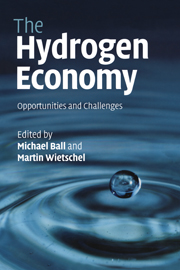Book contents
- Frontmatter
- Contents
- List of main contributors
- Preface
- Acknowledgements
- List of abbreviations
- 1 Scope of the book
- 2 Why hydrogen?
- 3 Non-renewable energy resources: fossil fuels – supply and future availability
- 4 Non-renewable energy resources: nuclear fuels
- 5 Assessment of the potentials for renewable energy sources
- 6 Carbon capture and storage
- 7 Energy-chain analysis of hydrogen and its competing alternative fuels for transport
- 8 Hydrogen today
- 9 Fundamental properties of hydrogen
- 10 Hydrogen production
- 11 Hydrogen storage
- 12 Hydrogen distribution
- 13 Key role of fuel cells
- 14 Hydrogen-infrastructure build-up in Europe
- 15 Building a hydrogen infrastructure in the USA
- 16 Hydrogen and the electricity sector
- 17 Hydrogen corridors
- 18 Macroeconomic impacts of hydrogen
- 19 Sustainable transport visions: the role of hydrogen and fuel-cell vehicle technologies
- 20 Energy-efficient solutions needed – paving the way for hydrogen
- 21 The future of hydrogen – opportunities and challenges
- Further reading
- Index
- References
2 - Why hydrogen?
Published online by Cambridge University Press: 22 January 2010
- Frontmatter
- Contents
- List of main contributors
- Preface
- Acknowledgements
- List of abbreviations
- 1 Scope of the book
- 2 Why hydrogen?
- 3 Non-renewable energy resources: fossil fuels – supply and future availability
- 4 Non-renewable energy resources: nuclear fuels
- 5 Assessment of the potentials for renewable energy sources
- 6 Carbon capture and storage
- 7 Energy-chain analysis of hydrogen and its competing alternative fuels for transport
- 8 Hydrogen today
- 9 Fundamental properties of hydrogen
- 10 Hydrogen production
- 11 Hydrogen storage
- 12 Hydrogen distribution
- 13 Key role of fuel cells
- 14 Hydrogen-infrastructure build-up in Europe
- 15 Building a hydrogen infrastructure in the USA
- 16 Hydrogen and the electricity sector
- 17 Hydrogen corridors
- 18 Macroeconomic impacts of hydrogen
- 19 Sustainable transport visions: the role of hydrogen and fuel-cell vehicle technologies
- 20 Energy-efficient solutions needed – paving the way for hydrogen
- 21 The future of hydrogen – opportunities and challenges
- Further reading
- Index
- References
Summary
The world is facing a new era of energy anxiety with complicated choices regarding fuel sources, new technologies, and government regulations and actions. There is also a growing global consensus that greenhouse-gas emissions need to be managed, resulting in the challenge to search for the best way to rein in emissions while also providing energy to sustain economies. The projected increase in global energy demand, and the economic and geopolitical implications of possible shortcomings in the supply of oil have been major drivers stirring the debate about the future energy supply. Supply disruptions of oil would primarily hit the transport sector, since this is still almost entirely dependent on oil worldwide. This situation is increasingly triggering the search for alternative automotive fuels. In this respect, hydrogen has in recent years been gaining increased attention.
This chapter addresses why. First, the challenges of today's energy system – security of supply and reduction of greenhouse-gas emissions – will be discussed and existing and emerging energy policies to cope with them will be addressed. This sets the scene for the introduction of hydrogen, which needs to be seen in the context of the development of the global energy scene. The possible emergence of a hydrogen economy is then reflected from the perspective of historical transitions of energy sources. Next, the major drivers for the possible transition to a hydrogen economy will be outlined as well as the potential benefits that could be expected from using hydrogen as an energy vector.
- Type
- Chapter
- Information
- The Hydrogen EconomyOpportunities and Challenges, pp. 8 - 45Publisher: Cambridge University PressPrint publication year: 2009
References
- 1
- Cited by



